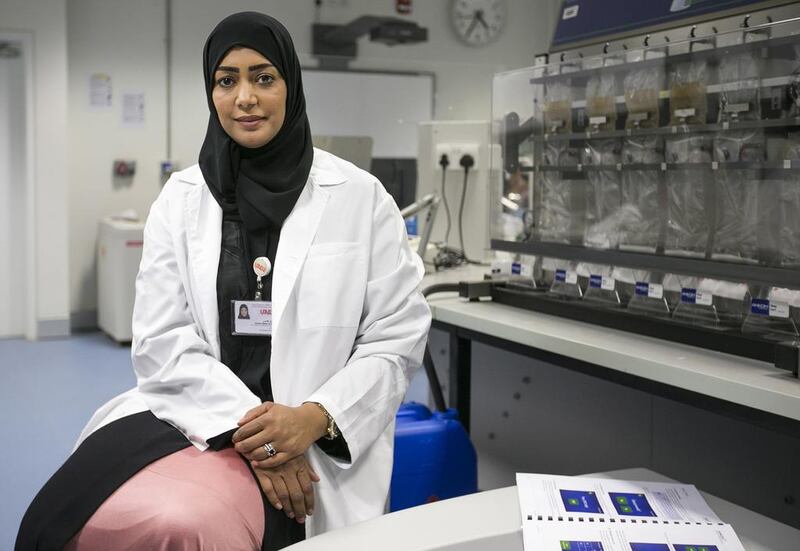ABU DHABI // A study has suggested a worryingly high rate of metabolic syndrome – often linked to obesity, diabetes and high blood pressure – among young Emirati women.
The UAE University recently studied 555 students aged between 17 and 25 and found that 39 of them had the condition.
S A, 23, had not heard of metabolic syndrome until the study found she had it.
“I was really worried and asked the researcher for help in understanding my situation,” she said.
Its rate among the young Emiratis is of concern, said lead researcher Dr Ayesha Al Dhaheri.
“I think finding a high prevalence earlier will be an alarm to act fast in reducing this number,” said Dr Al Dhaheri, chairwoman of UAEU’s nutrition and health department.
Metabolic syndrome is found in people who have several factors from a list linked to heart disease or Type 2 diabetes.
The study measured waists, body fat and weight of the students, and analysed their blood for cholesterol, fat and glucose.
The students also answered a questionnaire about their smoking, dietary and sleep habits.
Other studies in the Gulf had similar results. One found that 7.8 per cent of women aged 18 to 26 in Saudi Arabia had the condition, while among girls and young women aged 10 to 19 in Kuwait, the prevalence was at least 9 per cent.
These are much higher than in most other parts of the world.
The researchers note that other studies have indicated that the prevalence is 4.7 per cent among young women tested in America, 2.5 per cent in China and only 1.7 per cent in Brazil. In India, 11.7 per cent of the young women tested had metabolic syndrome.
It is also more common in older people, and one study from 2012 indicated that one in four people in the Middle East has the condition.
The paper’s eight authors, who are based at UAEU or the University of Oxford in the UK, said dietary changes and a lack of physical activity were partly to blame for the prevalence of obesity and related conditions in the UAE.
S A attributed her condition to lifestyle.
“I eat out most days and I do not go the gym as often as I should. I love eating chocolate and fries,” she said.
Researchers advised her to become more active and to eat less fast food, fried food and sugar.
“I am doing my best to reduce my weight and waist circumference. I also check my lipid profile regularly,” S A said.
A N, a 26-year-old from Dubai, was another who had metabolic syndrome diagnosed.
She said that among her friends, “most say we don’t have time to do exercise”.
“Most of the students, they are joining university or schools, so it’s easy for them to take fast food or junk food. It’s better than taking healthy food because it needs to be prepared,” she said.
“You can find healthy food in the supermarkets but they have the mentality to buy fast food.”
Dr Al Dhaheri said preventive measures were key to reducing the problems associated with the condition, which could lead to death if not dealt with.
“Early identification and regular screening of diseases should be introduced for this age group,” she said. “Also, awareness programmes should take place in schools and universities, especially when it comes to enhancing physical activity.
“The reduction in the consumption of a high calorie diet and following a healthy lifestyle can be emphasised.”
The most common characteristic linked to the syndrome among the participants was low levels of high-density lipoprotein, or “good cholesterol”, which was found among 48.8 per cent of participants.
Good cholesterol foods include beans and legumes, whole grains, high-fibre fruits, fatty fish and nuts.
The next most common characteristic was a large waist circumference, shown by 18.2 per cent.
The researchers suggest that genetic factors could also help to explain the syndrome’s prevalence.
They highlighted the “thrifty gene hypothesis” suggesting that during hunter-gatherer times, certain genes predisposed people to accumulate fat to tide them over when sustenance was unavailable.
In today’s world, such genes cause people to put on weight.
__________________________________
A dangerous combination
People are diagnosed with metabolic syndrome when they have at least three out of five related conditions – high blood pressure, high blood sugar levels, low levels of “good” cholesterol, a large waist and high levels of triglyceride fats.
These conditions, several of which have no clear symptoms, are often associated with a sedentary lifestyle, being overweight and with cells becoming resistant to insulin.
According to the Mayo Clinic in the United States, having any of the five increases the risk of serious illness, such as cardiovascular disease and diabetes, and having several means the dangers are higher still.
People with the syndrome are advised to have a healthier diet and to exercise more. As people age, they become more prone to the condition. Depending upon age and country, people may be more susceptible. Rates are high in the Middle East.
* The National
newsdesk@thenational.ae






